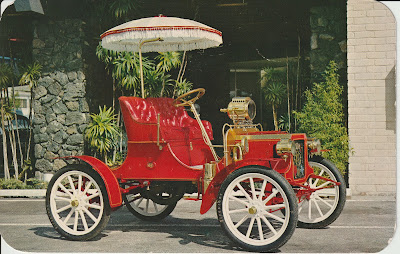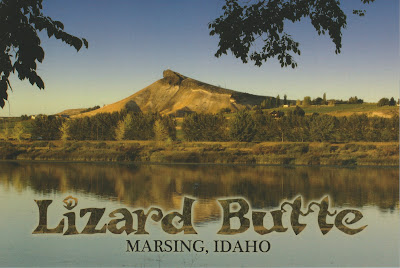REO Runabout, ca 1904-1908, postcard dates to before 1963
This is an advertisement postcard published and distributed by Pennzoil. The card has rounded edges and does not have a canceled postmark since it was a bulk rate mailer, making it difficult to be sure of the date. One clue is the two-digit mail code instead of the 5-digit zip code first used in 1963. The automobile featured in the photograph is identified as a 1904 REO Runabout. I tried to find other pictures of a 1904 REO runabout and was not successful. However, photos of both the 1906 and 1908 models show the same, hard to miss, large spotlight (?) on the hood.
Ransom Eli Olds founded the Olds Motor Vehicle Company in 1897. That company was bought out by Samuel L. Smith, a copper and lumber magnate in 1899. In 1901 the factory burned down and only one model, the small Curved Dash runabout was saved from the flames. Olds said that the fire was the reason he chose to produce the runabout out of all the many other models the company could have made. When Smith’s son Frederic L. Smith joined the company, he frequently clashed with Olds and finally removed Olds from the position of Vice President and general manager in 1904. Olds left his company and formed R.E.O. (his initials) in 1905.
In addition to the printed advertisement on the reverse congratulating new car owners and asking them to use Pennzoil, there is also a blurb at the upper left corner on the reverse: “1904 REO Runabout. Its single cylinder engine developed 8 h.p. With planetary transmission and cast-iron radiator, the REO weighed 850 lbs. and made about 25 mph. When this quaint automobile first appeared on the roads, Pennzoil was supplying ‘Tough-Film’ motor oil. Supreme in quality, this fine lubricant kept engines new then, as it does today.” Pennzoil was established in 1913.
Beautifully restored old automobiles called horseless carriages are a delight to see. Occasionally there are auto shows that only feature horseless carriages. We happened to be in Port Gamble a couple of months ago and saw the two restored vehicles in the photos below. They were operational and being used, headed most likely for an auto show. We did not meet the owners and did not ask about the cars, but did take time to cross the street and look at them. These were both Fords of about the same vintage as the REO on the postcard.








